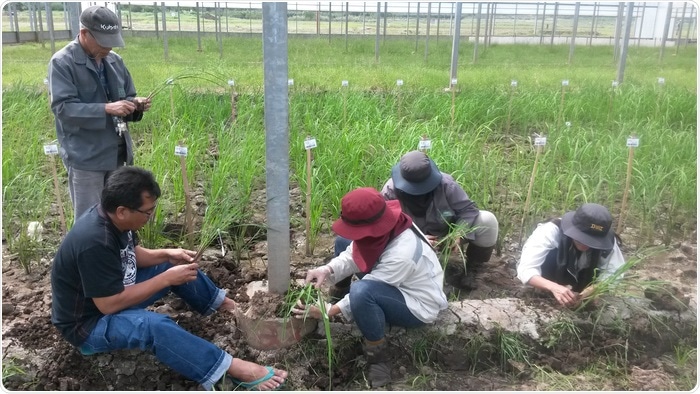Rice is not only a staple food but also a means of livelihood for numerous smallholder farmers in South and Southeast Asia. Generations of smallholder farmers depended on rainfall alone to irrigate the crops; however, the increasing severity and frequency of dry spells due to climate change exert immense pressure on the production of rice.

The researchers conducting their field experiment. Image Credit: Dr Amelia Henry, International Rice Research Institute, Los Baños, Laguna, Philippines.
Certain classic rice varieties cultivated in the regions adapted to the arid conditions might hold the key to creating strategies to enhance rice production under drought.
If we can identify the genes involved in drought resistance of traditional rice varieties, we can use this knowledge for breeding new, more stable-yielding, drought-resistant rice varieties.”
Dr Simon “Niels” Groen, Study First Author, University of California at Riverside
The research was published in The Plant Cell journal.
Dr Groen and his co-workers carried out a field experiment in the Philippines, spanning two years and involving numerous rice plants. The researchers used a panel of 20 different varieties of rice—some of which are known to withstand drought.
The researchers analyzed the impact of dry conditions in gene expression patterns in rice, how drought-stressed rice plants coordinate gene expression between their shoots and roots, and how the gene expression patterns are associated with traits that make plants more resilient in dry conditions.
The researchers cracked open rock-hard soil with the help of pickaxes and hammers to obtain root material for the research. Dr Groen remarks, “It was like searching for gold!” and the efforts paid off. The researchers discovered a series of traits associated with rice plant fitness under drought, like increased crown root density.
Drought influenced the gene expression patterns in the roots compared to that in the shoots; however, the researchers pinpointed modules of co-expressed genes associated with drought tolerance in both the roots and the shoots.
The majority of these modules had genes earlier associated with improved drought tolerance, like those involved in root-to-shoot water transport and photosynthesis. One module had genes recognized to be involved in interactions with soil-dwelling arbuscular mycorrhizal fungi. Interactions between the roots and beneficial soil organisms increase drought tolerance by enhancing nutrient access. The scientists are anxious to investigate this possibility.
The researchers anticipate that the gene modules pinpointed in the current research would guide efforts to breed resilient rice varieties, alleviating some of the pressures of a hotter, drier world.
They add, “We could see with our own eyes how drought can affect rice production and, most importantly, the lives of smallholder farmers in the area. This brought into perspective why we are doing the research that we are doing.”
Source:
Journal reference:
Groen, S. C., et al. (2021) Evolutionary systems biology reveals patterns of rice adaptation to drought-prone agro-ecosystems. The Plant Cell. doi.org/10.1093/plcell/koab275.